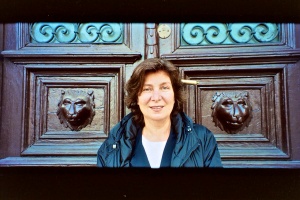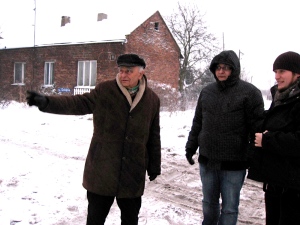
[photo: on the street in Radomsko. LS2021]
Preface
IN THE SPRING of 2021, KARTA Center in Warsaw brought out a Polish translation of my book, The Crooked Mirror, nine years after its publication in the United States. The book chronicles my decades-long immersion in the discomforting, sometimes surreal, and ultimately healing process of Polish-Jewish reconciliation.
I first visited Poland in 2000 and was privileged to observe, in that more hopeful time, the nation’s new openness to historical inquiry about its past after forty years of Communist rule, when it was taboo to discuss Polish collaborators, pogroms, or the killings of returning Jews after the war. I met brilliant artist-activists who were finding ways to commemorate the Jewish absence in their midst and to educate their communities about a history in danger of being lost or obscenely distorted. I also saw fresh stirrings of Jewish life in Poland, and a touching inquisitiveness among the young about Jewish identities kept hidden after the war.
In democratic Poland, it became possible for historians to examine the country’s wounds and losses under two regimes of tyranny. An important piece of the past was uncovered by Polish-born sociologist Jan Tomasz Gross, now professor emeritus at Princeton University. In 2001, he published Neighbors: The Destruction of the Jewish Community in Jedwabne, Poland, a book that set off what Polish journalist Anna Bikont called “a huge national psychotherapy session.” The debate was raw and very public.
Gross’s book laid out the bone-chilling details of the July 1941 massacre of almost the entire Jewish population of Jedwabne, a village in the northeast. Also in 2001, on the 60th anniversary of the crime, then-president Aleksander Kwaśniewski startled the nation by admitting for the first time that Polish civilians, not Nazi forces, were responsible for the killings. He offered an unflinching apology, carried live on Polish national television.
In recent years, however, the public conversation on controversial topics, Jedwabne among them, has radically devolved. In 2018, Poland’s government passed a law creating grounds for prosecution if anyone were to falsely lay blame on the Polish nation for crimes committed by Nazi or Soviet forces. This sparked concerns beyond Poland’s borders (and particularly among historians) as to how such a concept might be interpreted. When I wrote to Kostek Gebert, a journalist friend in Warsaw, to say I was coming in October 2021 to give two book talks — one in Radomsko, the other in Warsaw — he emailed me right away: “Expect to find a much nastier Poland.”
That’s what was on my mind the night before the scheduled book event for The Crooked Mirror at the Regional Museum in Radomsko, the town where my maternal grandparents were born, where my great-grandmother is buried, and where I found the house that was the last known address of my great-aunt Fayga Konarska Wilhelm before she and her family were deported to Treblinka. This would be my first return to Radomsko since my book was published in Polish. I couldn’t sleep. But at least I would be traveling with three trusted friends.
— Louise Steinman
¤
Our Day Begins
LAURIE WINER: Later I felt bad about brushing off Louise’s fears, telling her there was no reason to worry. I was spending a year abroad and decided to join her in Warsaw, where she was going to give a talk to some high schoolers — what could go wrong? We were driving from Warsaw to Radomsko, the town where Louise’s mother’s family had lived before World War II.
Radomsko’s wartime history was both shocking and not at all unusual: of its 10,000 Jews, only a couple of hundred survived. In her book, The Crooked Mirror, Louise explores the way that people and localities struggle all these decades later to cope with so profound a trauma. The Crooked Mirror is subtitled A Memoir of Polish-Jewish Reconciliation, and Louise begins it by admitting she inherited a specific prejudice from a mother who, though she never lived there, was so traumatized by her family’s history that she could barely say the words “Polish” or “Poland.” At the instigation of her Zen rabbi (this is a story, after all, that begins in Los Angeles), Louise attended a week-long Bearing Witness retreat at Auschwitz-Birkenau in 2000 and then traveled to her grandparents’ birthplace to find out more about the fate of her ancestors. She returned to Poland a dozen times over two decades, inevitably grappling with the mystery of mysteries: why groups of humans are sometimes stirred to kill other groups of humans, and with a savagery so astonishing that no one — victim, perpetrator, bystander — is left whole. In Radomsko, we soon found out, the wounds were still raw.
Louise had just heard through her editor that there was a Radomsker gentleman, an innkeeper, who was unhappy with her depiction of him in her book. And a few weeks earlier, she’d received an email from another man who said she’d gotten some things wrong about his family.
I was not worried. As a theater critic for many years, I had received numerous letters from people who actively wished for my physical demise because I disliked a show. I developed a hard shell about such grievances. Also, this talk was taking place in public, at an institution that had invited Louise, and she would be traveling with three friends — her translator Dorota, her editor Hanna, and me — all of whom, I’d like to think, could handle any situation that might arise.
DOROTA GOLEBIEWSKA: My first response to the invitation to go with Louise to Radomsko was sheer enthusiasm. Hooray! I could finally see all the places I had heard and read about — places that, sorry to say, although Polish myself, I had never visited. There was to be a public meeting at the Regional Museum. Would I translate? Sure I would. I reassured Hanna everything would go well — after all, Louise and the townspeople had become friends, hadn’t they?
HANNA ANTOS: The day before our trip I had a rather difficult phone conversation with a man mentioned briefly in The Crooked Mirror. Someone underlined for him a few phrases describing his posture and behavior, which he found unfair. I tried to assure him that there was nothing offensive in the description, that it was definitely not the author’s intention to offend him (or anybody else from Radomsko), and that she was grateful for his care of the Jewish cemetery. I asked him to read the whole book, not only the underlined sentences, and hoped that he would understand that Louise reveals her own initial prejudices and her efforts to overcome them. She reaches out to Poles who do the same, so that both parties could find some common understanding of the past — leading to a true, if not ideal, reconciliation. That’s the core of The Crooked Mirror, not the details describing how she saw and remembered a particular person from 20 years ago.
Heading to Radomsko, I was only slightly worried about the expected attendance — about how many people would show up apart from the high school class.
Continue reading in Los Angeles Review of Books



 I can’t let 2015 fade into the night without making mention of a remarkable man who passed away in a little town in central Poland on December 20, the day before the winter solstice.
I can’t let 2015 fade into the night without making mention of a remarkable man who passed away in a little town in central Poland on December 20, the day before the winter solstice.
 I will always remember that remarkable winter day in an empty hotel dining room in Radomsko, with snow falling outside the windows– when Marian met with me, his grandson Szymon (who helped persuade his grandfather that it was safe now to tell his story), my journalist friend Maciej Ziembinski, and my translator Tomasz Cebulski, to tell us his story, even sketching out the dimensions of the bunker in my little black notebook—the trapdoor in the kitchen, the second door to the potato cellar. His mother Janina was a young widow with young children (Marian was eight). They hid five people—Berek Ofman, his schoolmate Regina Epstein, her parents, and her cousin– in their bunker for two years. Young Marian procured food for the hidden guests, trading linens for bread. They came close to disaster more than once. In occupied Poland, the Nazi’s penalty for anyone found hiding Jews was death for the entire family.
I will always remember that remarkable winter day in an empty hotel dining room in Radomsko, with snow falling outside the windows– when Marian met with me, his grandson Szymon (who helped persuade his grandfather that it was safe now to tell his story), my journalist friend Maciej Ziembinski, and my translator Tomasz Cebulski, to tell us his story, even sketching out the dimensions of the bunker in my little black notebook—the trapdoor in the kitchen, the second door to the potato cellar. His mother Janina was a young widow with young children (Marian was eight). They hid five people—Berek Ofman, his schoolmate Regina Epstein, her parents, and her cousin– in their bunker for two years. Young Marian procured food for the hidden guests, trading linens for bread. They came close to disaster more than once. In occupied Poland, the Nazi’s penalty for anyone found hiding Jews was death for the entire family.















